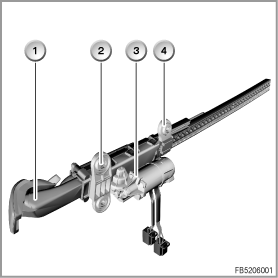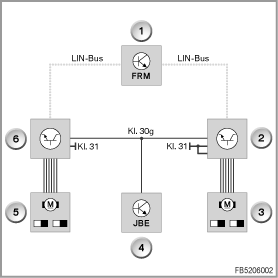
Coupés have larger doors. In that the B-pillar is further towards the rear, it is not as easy to reach the belts as in Saloons.
When fastening the seat belt, unergonomic twisting of the body would be necessary. In surveys in the USA, this led to negative assessments by customers.
BMW is using a belt hand-over as series standard for the first time on the E92.
Advantage: more convenient reaching for the belt.
The belt hand-over on the passenger's side is only activated if the seat is occupied.
This function logic is a competitive advantage.
The following components are described for the belt hand-over:
When retracted, the belt hand-over is integrated in the side trim panel and invisible. It fits harmoniously into the design of the passenger compartment. The belt hand-over consists of the following components:

Index |
Explanation |
Index |
Explanation |
|---|---|---|---|
1 |
Arm of the belt hand-over |
2 |
Bracket |
3 |
Drive with gearing |
4 |
Bracket |
The belt hand-over moves out to a maximum of 350 mm. Extension and retraction take less than 2 seconds.
The belt hand-over controller activates the drive of the belt hand-over. The position of the drive is indicated to the belt hand-over controller by a Hall sensor in the drive.
The end position of the extended belt hand-over is picked up by another Hall sensor. The end position is signalled to the belt hand-over controller.
Both signals are sent by the belt hand-over controller via the LIN bus to the footwell module (FRM).

Index |
Explanation |
Index |
Explanation |
|---|---|---|---|
1 |
Footwell module (FRM) |
2 |
Belt hand-over controller |
3 |
Drive with Hall sensor and Hall sensor for end position |
4 |
Junction box electronics (JBE) |
5 |
Drive with Hall sensor and Hall sensor for end position |
6 |
Belt hand-over controller |
LIN |
Local Interconnect Network Bus |
Terminal 30g |
Terminal 30 switched |
Terminal 31 |
Terminal 31 |
|
|
The front belt lock contacts detect whether the belt is inserted in the belt buckle. The signal is sent to the multiple restraint system (MRS).
The seat occupation detection on the passenger's side detects whether the seat is occupied. The CAS supplies the seat occupation detection with terminal R.
The following control units are involved in the belt hand-over function:
The footwell module (FRM) activates the two belt hand-over controllers for the driver's and passenger's side. The belt hand-over controllers are connected across an LIN bus on the footwell module. The software for activation is in the footwell module.
The belt lock contacts on the driver's and passenger's sides are connected to the multiple restraint system (MRS). The MRS control unit is connected to the FRM via the body CAN. The MRS control unit forwards the signals from the belt lock contacts.
The Car Access System (CAS) is the master control unit for the terminal control.
The CAS sends the terminal status on the bus.
The CAS also signals the seat occupation detection on the passenger's side, terminal R.
Together with the junction box electronics, the distribution box forms the junction box. The distribution box supplies the belt hand-over controller with terminal 30g.
The following system functions are described for the belt hand-over:
The belt hand-over on the driver's side is extended according to the following function logic:
Initial state |
Action |
Function |
|---|---|---|
Terminal 30, driver's door closed, belt lock contact open, belt hand-over retracted, door change driver's door taken place since last double-unlocking, identification sensor in the vehicle with Comfort Access |
Terminal change from terminal 30 to R |
Belt hand-over on driver's side extends |
Terminal change from terminal R to 15 |
||
Terminal R or 15, driver's door open, belt lock contact open, belt hand-over retracted, identification sensor in the vehicle with Comfort Access |
Close driver's door |
Belt hand-over on driver's side extends |
The belt hand-over on the passenger's side is extended according to the following function logic:
Initial state |
Action |
Function |
|---|---|---|
Terminal 30, passenger's door closed, belt lock contact open, belt hand-over retracted, signal change for passenger's door taken place since the last double-unlocking, identification sensor in the vehicle with Comfort Access |
Terminal change from terminal 30 to R |
Belt hand-over on passenger's side extends |
Terminal R, passenger's door closed, belt lock contact open, belt hand-over retracted, signal change for passenger's door taken place since last double-unlocking, passenger's seat detected as occupied or time less than 10 seconds after terminal R On, identification sensor in the vehicle with Comfort Access |
Terminal change from terminal R to 15 |
Belt hand-over on passenger's side extends |
Terminal R or 15, passenger's door open, belt lock contact open, belt hand-over retracted, signal change for passenger's door taken place since last double-unlocking, seat detected as occupied or time less than 10 seconds after terminal R On, identification sensor in the vehicle with Comfort Access |
Close door |
Belt hand-over on passenger's side extends |
The belt hand-over on the driver's side and passenger's side is retracted according to the following function logic:
Initial state |
Action |
Function |
|---|---|---|
Belt hand-over extended, door closed |
Close belt lock contact |
Belt hand-over retracts |
Vehicle speed higher than 7 kph |
||
Belt hand-over in extended position longer than 60 seconds |
||
Opening door |
||
Mechanical blocking |
||
Belt hand-over extended, door closed, terminal R |
Terminal change from R to 30 |
Belt hand-over retracts |
The belt hand-over on the passenger's side is also retracted according to the following function logic:
Initial state |
Action |
Function |
|---|---|---|
Belt hand-over extended, door closed, terminal R or 15, seat not occupied |
Time equals 10 seconds after terminal R On |
Belt hand-over (front passenger) retracts, signal change passenger's door is deleted |
As blocking protection on extending, the belt hand-over reverses 20 mm if it encounters an obstacle. The Hall sensor in the drive runs the blockage identification of the belt hand-over.
The front section of the belt hand-over folds back mechanically on retraction to provide blocking protection.
The drive of the belt hand-over has overheating protection. After activation of the drive a number of times, the overheating protection is activated.
A voltage greater than 16 Volts is regarded as overvoltage.
A voltage less than 9 Volts is regarded as undervoltage.
In both cases, the belt hand-over is not activated.
Note: blocking protection on retraction of the belt hand-over!
The front section of the belt hand-over folds back mechanically on retraction to provide blocking protection. This is not a defect.
Note: belt hand-over controller with 2 earth connections!
In order to distinguish the installation location, the belt hand-over controller on the passenger's side has an additional coding pin. Terminal 31 is applied on the coding pin.
Instead of the seat occupation detection, the passenger seat occupation mat US is connected to the multiple restraint system (MRS).
No liability can be accepted for printing or other errors. Subject to changes of a technical nature